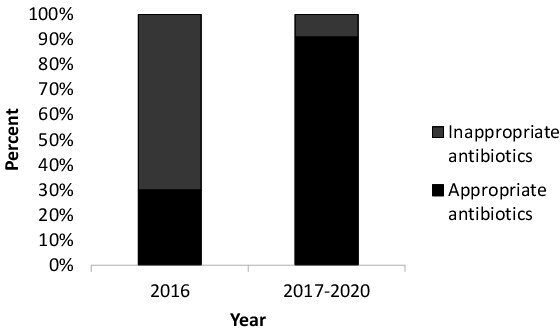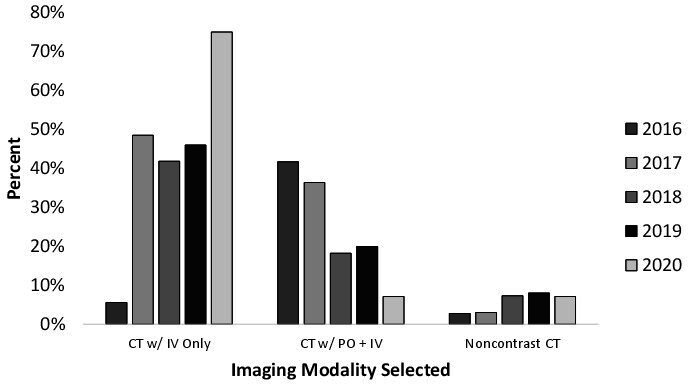
Click to Enlarge: Surgical resident antibiotic stewardship before and after targeted education in January 2017. These antibiotics were ordered by the surgical team and administered to the patient in the operating room prior to surgery. Antibiotic selection was classified as ‘appropriate’ (according to the protocol) or ‘inappropriate’. Source: BMJ Open Quality
BETHESDA, MD — Targeted in-person education and visible signs in the emergency department can increase adherence to institutional protocols designed to improve compliance with best practices for treating uncomplicated acute appendicitis, according to a recent study.
The study published in BMJ Open Quality explored ways to improve adherence to a protocol for uncomplicated acute appendicitis and achieve higher-quality management of this disease. Study authors are affiliated with Walter Reed National Military Medical Center and Uniformed Services University of the Health Sciences, both in Bethesda, MD.1
Acute appendicitis is “one of the most common indications for emergency general surgery and costs the U.S. healthcare system an average of $7.8 billion despite its low associated morbidity and mortality,” study authors explained, adding that, to optimize care of acute appendicitis and avoid unnecessary variation in treatment, healthcare institutions have been developing evidence-based protocol and quality metrics.
In 2016, an institution-wide protocol for uncomplicated acute appendicitis was created at a military treatment facility (MTF) “to improve compliance with best practices between the emergency department, radiology and surgery,” according to the study. The goal of the protocol was to “reduce treatment variability, increase efficiency and improve quality of care delivered to emergency general surgery patients,” the authors wrote in the paper. “For patients who meet inclusion criteria, the protocol specified preferred initial imaging modalities for suspected acute appendicitis, antibiotic selection, postoperative analgesia, diet progression, discharge criteria and follow-up expectations.”
The MTF spread awareness about the protocol through a smartphone application and communication to clinical leadership, but metrics showed poor protocol adherence in diagnostic imaging and antimicrobial stewardship. As a result, the authors hypothesized that two simple interventions, “brief targeted surgery resident education and adding easy-to-read reference signs in locations immediately adjacent to provider workstations, would result in improved protocol adherence and higher quality management of acute appendicitis.”

Click to Enlarge: Selected imaging modality proportions by year. w/IV, with intravenous contrast; w/PO, with per oral contrast. Source: BMJ Open Quality
To implement the protocol, “surgery residents received targeted in-person education on the appropriate antibiotic choices and diagnostic imaging. Also, signs highlighting the preferred imaging for patients with suspected appendicitis and the preferred antibiotic choices for those with proven appendicitis were placed in the emergency and radiology work areas, immediately adjacent to provider workstations. Protocol adherence was compared before and after each intervention,” study authors explained.
Electronic medical records of 202 patients with appendicitis who presented to the emergency department and who underwent appendectomy from the time the outpatient laparoscopic appendectomy protocol was implemented in January 2016 through the end of the year 2020 were identified from department surgical case logs and reviewed.
The study found that “targeted in-person education reinforcement and visible signage immediately adjacent to provider workstations were associated with significantly increased adherence,” according to the study.
Targeted education “was associated with improved antibiotic stewardship within the surgical department from 30% before intervention to 91% protocol adherence after intervention,” study authors reported. Also, visible signs in the emergency department “were associated with expedited antimicrobial administration from 50% before intervention to 90% after intervention of patients receiving antibiotics in the emergency department prior to being brought to the operating room.” In addition, they pointed out, “diagnostic imaging after the placement of signs resulted in improved protocol adherence from 35% to 75%.”
Protocol Compliance
The study “demonstrates the positive effects of low-cost, easy-to-implement educational and physical measures that improved protocol compliance and patient care,” the researchers pointed out. Implementing simple interventions with targeted education and physical signs could lead to “improved compliance, decreased costs and improved patient outcomes,” according to the study.
Similar efforts can be used in “other aspects of acute care general surgery to further improve quality of care and hospital efficiency,” the researchers suggested.
Meanwhile, “smartphone-based applications and communication to clinical leadership achieved suboptimal protocol adherence,” the study advised.
The results demonstrated that “creating an outpatient laparoscopic appendectomy protocol, assessing adherence to the protocol and taking actions to fix weaknesses have improved hospital efficiency and quality of care in the management of patients with uncomplicated acute appendicitis,” the authors explained.
This model offers an easy way to improve the quality and efficiency of care, and protocols are being implemented for other common acute surgical diseases, according to the researchers, who recommend creating additional protocols for other appropriate cases in healthy patient populations.
A limitation of the study is that only a single institution was involved. Because this institution was a military treatment facility, there might be limits on applying the protocol to other healthcare settings, according to the study. The researchers also noted that having too many signs or too many clinical practice guidelines could overwhelm physicians and lead to worsened compliance.
- Atwood R, Benoit P, Hennrikus W, Kraemer L, Gunasingha RM, Kindvall A, Jessie E, Gosztyla C, Bradley M. Simple signage and targeted education can lead to process improvement in acute appendicitis care. BMJ Open Qual. 2023 Oct;12(4):e002327. doi: 10.1136/bmjoq-2023-002327. PMID: 37879672; PMCID: PMC10603529.
